Dishwasher washing cycle or how long the program lasts: an inside look
Actively operated dishwasher greatly simplifies the life of every housewife. Choosing this type of household appliances, many focus on the appearance, but the functionality is more important. To evaluate the usefulness of the model, you need to know how long the dishwasher washing cycle lasts, and decide whether they are suitable for you.
You will learn all about the duration of standard and additional operating modes of dishwashers from our article. We will tell you how to choose equipment with the functionality that suits you personally. Lean housewives will find useful tips at our place to reduce operating costs.
The content of the article:
The internal structure of the dishwasher
At first glance, the operation of the dishwasher seems simple: the unit is installed, connected, the detergents are put in the right places, the utensils are placed, the program is selected, the equipment is launched. Then you can forget about the dishes for a while and do something more pleasant.
But I wonder what happens at this time inside the dishwasher? After starting the machine, water enters a special tray through an open valve. Enriched with detergents and regenerating salt, it heats up to the temperature that you set.
The process itself is identical to washing dishes manually. In detail, the device and the principle of operation of dishwashing equipment described here. We recommend that you read some very useful information.
It depends on the program you have installed and consists of three to four stages:
- soaking if the dishes are very dirty;
- washing;
- rinsing;
- drying.
The duration of these periods is influenced by the initially set water heating temperature. The higher the threshold you set, the longer you have to wait for the end of the cycle.

When soaking, which is sometimes called a preliminary wash, the main dirt is washed off the dishes with cold water without using chemicals from the main tank. This function is convenient if the dishes are loaded into the machine in stages as they accumulate. It will prevent stubborn dirt from sticking to previously loaded kitchen items.
The washing itself involves processing dishes with hot water at about 80ºC. You can simply increase the washing time, but the advantage of the first option is that the cleaning components are not used.
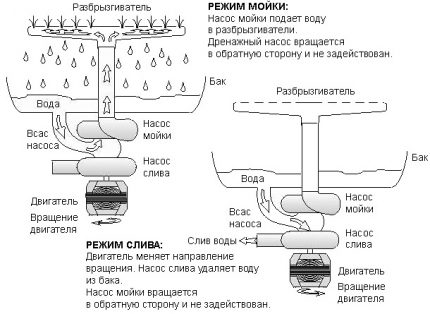
Water along with the chemical composition is sprayed using special tubes located at the top or bottom of the housing. Rocker cleans dishes more efficiently. During rotation, it sprays water jets in all directions under powerful pressure.
At the end of the washing phase, the PMM automatically includes the next one - rinsing and drying.

Rinsing in a dishwasher, similar to a washing machine, involves two steps. Only in this way can detergents be completely removed from all surfaces of washed dishes.
Standard operating modes
Dishwasher programs are a series of operations that a microprocessor performs.
The main parameters are:
- The presence or absence of pre-soaking.
- Water heating temperature.
- Program duration.
After repeated use, the PMM will easily recognize how it functions and, by ear, identify malfunctions.
Drying Types in PMM
Drying completes the washing cycle. It is of three types - blowing with heated air (turbo-drying), an intensive process with a heat exchanger and condensation.
The first method involves blowing treated dishes with warm jets of air. The implementation of the process is possible due to the presence of a fan built into the design. Drying is accelerated, but increased energy consumption.
Intensive drying is carried out due to the independent movement of air inside the housing as a result of the pressure difference. This method gives good results at a more economical use of electricity.
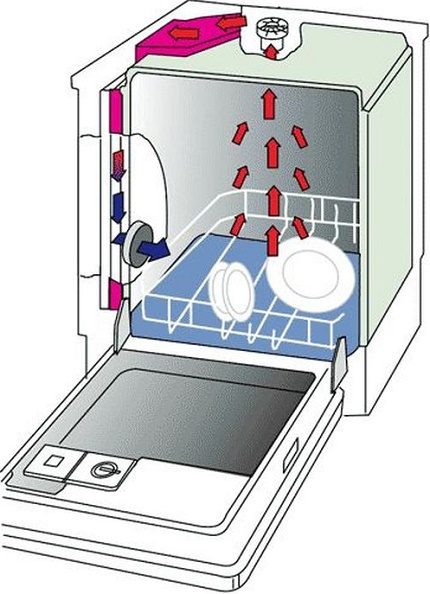
During condensation drying, drops of water evaporating from the surface of the dishes are transformed into condensate and settle on the walls, then flow down. This drying method takes a lot of time, but if there is no hurry, then this method is the best.
Standard cycle time
Modes for different PMM models may vary. Nevertheless, there are four basic modes of washing in the dishwasher, which each manufacturer puts into its program. These modes are called fast, normal, economical, intense. We will consider each of them as guidelines dishwasher selection.
When choosing a quick wash, the pre-wash and drying function disappears. The process lasts about half an hour. In the instructions for some models, this type of dishware is called rinsing. Apply this mode when a small amount of not very dirty dishes has accumulated.
In normal mode, including a fully completed cycle, the dishwasher works on average two hours, of which:
- Rinsing - from 5 to 10 minutes.
- Main wash - up to 50 minutes at a water temperature of 65⁰.
- Rinse in three steps - up to 10 minutes
- Drying - rest of the time.
Economy mode significantly reduces time by increasing temperature and pressure. This takes less water, but the energy consumption increases. The program contains preliminary rinsing, washing at 50⁰, double rinsing, drying.
Very dirty dishes are washed using an intensive regimen lasting 2-3 hours. This program includes pre-rinsing, washing at 70⁰, rinsing in four steps, drying.
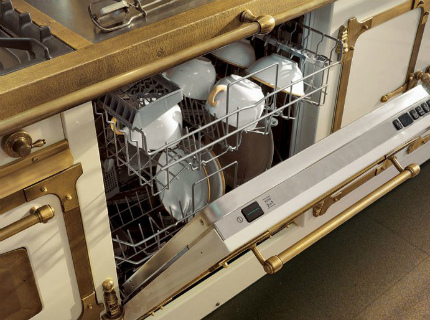
Pans and pans are best washed in pre-soak mode. Especially greasy kitchen utensils should be kept in the sink under a stream of very hot water before loading. This will help the dishwasher to better cope with the task.
Some models are also equipped with such programs:
- Eatload-runallowing dishes to be loaded immediately from the dining table. A quick wash occurs at 65⁰, then rinsing and drying, and all this in 30 minutes.
- Delicate sink at 45⁰. Apply for crystal, porcelain, glass. Duration - 110 minutes.
- Car wash (Auto) - this program without outside interference determines the degree of contamination and automatically sets the right amount of water, detergents and the duration of the process. The usual water temperature in this mode is from 45 to 65⁰, the duration is 2 hours 40 minutes.
The latest PMM models have a function Varlo speed, allowing to reduce time by 50%. Not everything is so simple here - while saving time, electricity consumption is growing. When choosing a mode, you need to calculate what is more profitable for you - saving time or electricity.
Floor models with a minimum of eight sets have half load mode. This means that only one basket of the two available is loaded. At the same time, the washing time is not reduced, but there is a decrease in the volume of water used, detergents, and electricity.
Variable Wash Program It provides for simultaneous processes - washing dishes in an intensive mode and soaking. These two works take place in different baskets. Application of the program allows saving about 25% of water while maintaining excellent quality of washing.
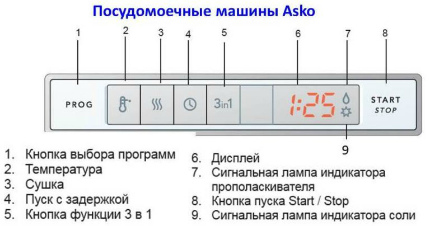
The function is sometimes very relevant. “Delayed launch”. With its help, you can move the start at a time of 1 - 24 hours. In the presence of a double tariff for electricity - this is very convenient.
Additional PMM Functions
In parallel with the dishwasher modes, they can have additional functions. Almost all of them are equipped with leakage protection. If the house has small children, an aggregate with the ability to lock the control panel or door is needed.
The possibility of adding forgotten dishes after starting the machine is also a very convenient feature. Elite models are equipped with load sensors. In this mode, the PMM selects both the volume of water and the time taken for the cycle.
Some models have additional elements - sensors for monitoring the purity and hardness of the water. The sensor for monitoring the degree of purity of water forces the unit to rinse everything loaded into the machine until the liquid becomes perfectly clean. If the water is very hard, the machine will determine how much emollient salt needs to be added.
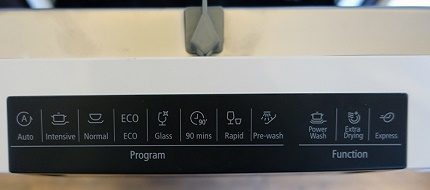
Built-in units in working condition project a red beam onto the floor plane. When the process ends, it disappears or its color changes to green. This is very convenient because gives you the opportunity to monitor work built-in dishwasher.
Management of washing modes
All modes in the PMM are coordinated in two ways: electromechanical and electronic. The second method is more comfortable, and all modern models are equipped with it. The first involves the presence of buttons, switches and keys on the case, and they are controlled manually.

With electronic control, both the washing mode and the rest of the programs are set using commands. If the PMM board fails, only the master can repair it. As experience shows, most often the programmer will have to be changed.
The final stage of the machine
At the end of the cycle, the contaminated liquid goes into the sewer. This is followed by a drying step. It can end in 30 minutes, and last more than an hour.
A special signal sent by the device will notify about the end of the program. The sound volume is controlled by convenient indicators placed by the manufacturer on the control panel. With their help, you can completely disable the notification function if you plan to load the car at night.
When the unit stops completely, press the on / off key. Then the door is slightly opened in order to more quickly cool the dishes.
After drying, the temperature inside the unit remains high, so it is not recommended to immediately release it from its contents. In addition, cookware made from certain materials when hot becomes very fragile.

It happens that the cycle is completed, and the dishwasher does not turn off. The most likely cause is problems with the electronics. This may be due to clogging of the drain hole with food debris. The machine cannot complete the job correctly.
Duration of programs for some models
Let's see how the duration of the modes differs for individual PMM models. To this end, we will analyze several popular samples of dishwashers of different brands and the duration of washing with these machines.

According to reviews by many users, it can be concluded that the most commonly used modes are fast and intense.
Water saving in dishwashers
Both the selected washing mode and the PMM model determine how much water it will consume. On average, it is from 10 to 13 liters per procedure as a whole. Unlike manual washing, all water is used only for its intended purpose without any loss.
In the process, the working fluid is cleaned by means of special filters and for rinsing comes completely updated. Saving modes reduce the amount of water consumed by 25%.

Profitability PMM is indicated by symbols. Highly efficient units are marked with the letters A, B, C. They consume 9-16 liters. Medium-efficient dishwashers are designated in the form of letters D, E. They consume slightly more water - up to 20 liters. Low-cost cars with letters F, G per cycle need 26 liters.
How to load the dishes?
Sometimes improper loading of dishes becomes the reason for the failure of the PMM programs laid down in it and, as a result, deterioration in the quality of washing. All the subtleties loading dishes into the machine are listed in our recommended article.
If you place large kitchen utensils in the center - pots, pans, baking sheets, chopping boards, trays, the water stream will be blocked. It is better to move all this closer to the edges or lower it into the lower compartment.
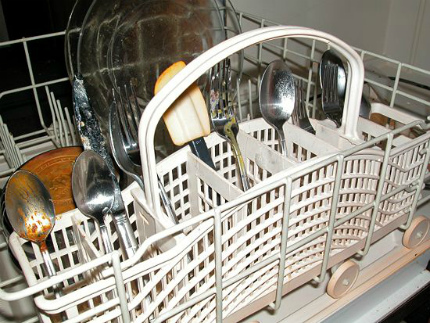
When a large quantity of dishes to be washed accumulates, it is impossible to process all of it at a time. Water and detergents will not have enough free contact with the surfaces of kitchen utensils.
To do this, free spaces should remain between the kitchen utensils. In case of overload, the dishwasher will not be able to perform its work efficiently.
For the dishwasher to function properly, it is important that powder or detergent tablets were strictly in the designated compartment. Due to the fact that the cycle is programmed in advance, all means come into effect clearly at the set time.
If stains remain on the dishes, this indicates an excess of salt or rinse aid. When there are not enough cleaning products, dirty streaks will remain. If food residues are found at the bottom of the unit and on the dishes, the filters should be checked. Most likely, they are clogged. Experts advise cleaning them after one or two sinks.
Long-washed or burnt utensils are subject to preliminary manual cleaning. When an excess of foam forms during rinsing, it means that an excess amount of rinse aid has been loaded. In this case, the correct setting of the dispenser or the addition of an antifoam in the form of a powder will help.
Conclusions and useful video on the topic
Processes that occur in the machine during operation:
It is difficult to wash the dishes by hand in very hot water. PMM does it better. Washing time depends directly on the selected mode, model of technology. The fact that its use not only saves resources, but also the time that is spent on daily washing of kitchen utensils, also speaks in favor of dishwashing equipment.
Do you want to share your own experience in operating a dishwasher and in choosing the appropriate cycle of work? There is information on the topic of the article, which is useful to site visitors? Please write comments in the block below, post a photo and ask questions about your points of interest.

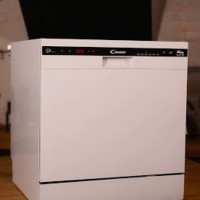 Candy CDCF 6E-07 dishwasher overview: is it worth buying a miniature
Candy CDCF 6E-07 dishwasher overview: is it worth buying a miniature 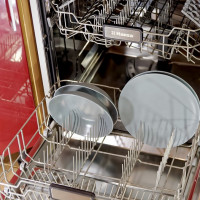 Hansa ZIM 476 H dishwasher overview: functional assistant for one year
Hansa ZIM 476 H dishwasher overview: functional assistant for one year 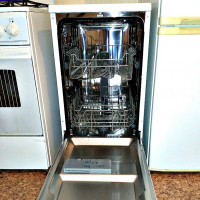 Overview of the dishwasher Hansa ZWM 416 WH: profitability is the key to popularity
Overview of the dishwasher Hansa ZWM 416 WH: profitability is the key to popularity  Overview of the Electrolux ESL94200LO dishwasher: what are the causes of overpopularity?
Overview of the Electrolux ESL94200LO dishwasher: what are the causes of overpopularity?  Bosch SPS40E32RU dishwasher overview: innovative designs at a modest price
Bosch SPS40E32RU dishwasher overview: innovative designs at a modest price 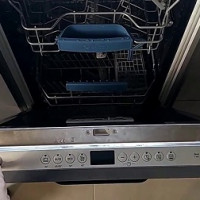 Overview of the Bosch SPV47E40RU dishwasher: economical consumption of resources when washing class A
Overview of the Bosch SPV47E40RU dishwasher: economical consumption of resources when washing class A  How much does it cost to connect gas to a private house: the price of organizing gas supply
How much does it cost to connect gas to a private house: the price of organizing gas supply  The best washing machines with dryer: model rating and customer tips
The best washing machines with dryer: model rating and customer tips  What is the color temperature of light and the nuances of choosing the temperature of the lamps to suit your needs
What is the color temperature of light and the nuances of choosing the temperature of the lamps to suit your needs  Replacement of a geyser in an apartment: replacement paperwork + basic norms and requirements
Replacement of a geyser in an apartment: replacement paperwork + basic norms and requirements
I read something around my head ... About the automatic mode, when the machine itself determines how to wash the dishes ... I did not understand how she does it. So far, all the associations that there are about automatic modes, this is the “auto” mode in the camera. Nothing good - average quality without taking into account the features of portraiture or landscape. Will there be something similar in the dishwasher - the “average” mode, which will not give perfectly clean dishes?
I don’t know how auto mode works on cameras, but I have a dishwasher - this is the main mode, I use it in 95%. Washes no worse than intensive washing. Sensors work smartly.
There is nothing complicated in the automatic mode of the dishwasher. Inside the dishwasher there is a special aquasensor (turbidity sensor), it sends an infrared beam through the water, which gets on the phototransistor.Further, the computer (to be more precise microprocessor) of the dishwasher determines the degree of water pollution. After each rinse cycle, calibration is performed again until the water is clear.
This is a very convenient mode, although it is not present in all dishwashers. The only thing is, once every several years (4-5) it is worth cleaning this sensor, because over time it becomes contaminated with the remains of powder, salt, fats, etc. and
begins to incorrectly detect pollution.
It is always useful to know how home electrical appliances work from the inside out. Understanding how this all works, it is much easier to figure out in the event of a possible malfunction or breakdown. I usually use two to three dishwasher programs. In the rest, to be honest, I didn’t even understand much. It will be necessary to find the time, take the instructions and carefully study it.
After reading the article, everything fell into place. Thanks to the author. In my practice there were three dishwashers, now it’s clear why Bosch washes dishes in 2 hours and perfectly dries. And the Chinese garbage Coopersberg washes 3.5 hours and the dishes are wet. In my opinion, it is better not to save electricity and enjoy fast and high-quality washing and drying.